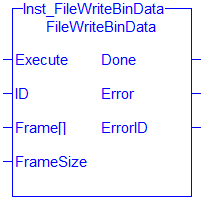FileWriteBinData
![]()
 Function Block
Function Block![]() A function block groups an algorithm and a set of private data. It has inputs and outputs. - Write binary data to a file.
A function block groups an algorithm and a set of private data. It has inputs and outputs. - Write binary data to a file.
Inputs
|
Input |
Data Type |
Range |
Unit |
Default |
Description |
|---|---|---|---|---|---|
|
Execute |
BOOL |
0, 1 |
N/A |
No default |
On the rising edge |
|
ID |
UDINT |
N/A |
N/A |
No default |
The ID of the open file. |
|
USINT[ ] |
N/A |
N/A |
No default |
The array of binary data to write. |
|
|
FrameSize |
DINT |
N/A |
N/A |
No default |
Number of bytes to write from the Frame array. |
Outputs
|
Output |
Data Type |
Range |
Unit |
Description |
|---|---|---|---|---|
|
Done |
BOOL |
|
|
If TRUE, the command completed successfully. |
|
Error |
BOOL |
|
|
If TRUE, an error has occurred. |
|
ErrorID |
DINT |
|
|
Indicates the error if Error output is TRUE. See the table in Search IndexFile and TCP/IP Function Block ErrorIDs. |
Remarks
Before using FileWriteBinData, use SerializeOut to copy variable data to a binary frame.
Figure 6-274: FileWriteLine
FBD Language Example
Not available.
FFLD Language Example
Not available.
IL Language Example
Not available.
ST Language Example
(* FileWriteBinData example *)
CASE StepCounter OF
0:
Inst_FileWriteBinData(TRUE, MyOutputFileID, OutputFrame, 128);
StepCounter := StepCounter + 1;
1:
Inst_FileWriteBinData(TRUE, MyOutputFileID, OutputFrame, 128);
IF Inst_FileWriteBinData.Done THEN
Inst_FileWriteBinData(FALSE, 0, OutputFrame, 0);
StepCounter := StepCounter + 1;
END_IF;
END_CASE;
See Also







